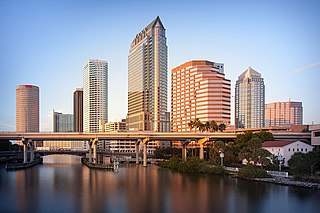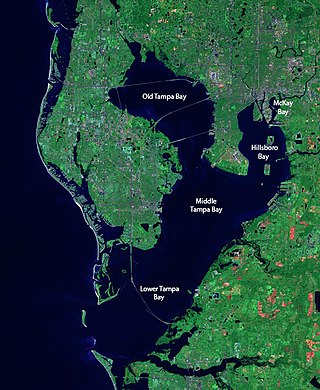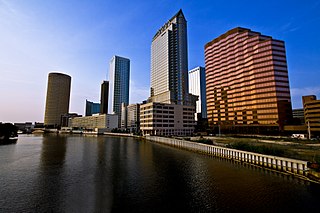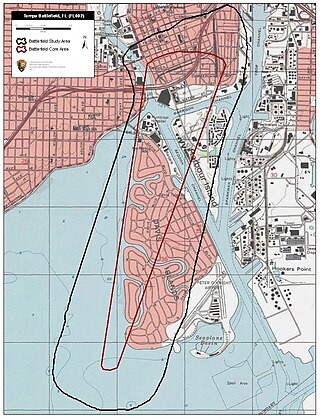
Tampa is a city on the Gulf Coast of the U.S. state of Florida. The city's borders include the north shore of Tampa Bay and the east shore of Old Tampa Bay. Tampa is the largest city in the Tampa Bay area and the seat of Hillsborough County. With an estimated population of 398,173 in 2022, Tampa is the 49th-most populous city in the country and the third-most populous city in Florida after Jacksonville and Miami.

Tampa Bay is a large natural harbor and shallow estuary connected to the Gulf of Mexico on the west-central coast of Florida, comprising Hillsborough Bay, McKay Bay, Old Tampa Bay, Middle Tampa Bay, and Lower Tampa Bay. The largest freshwater inflow into the bay is the Hillsborough River, which flows into Hillsborough Bay in downtown Tampa. Many other smaller rivers and streams also flow into Tampa Bay, resulting in a large watershed area.

The Hillsborough River is a river located in the state of Florida in the United States. It arises in the Green Swamp near the juncture of Hillsborough, Pasco and Polk counties, and flows 60 miles (97 km) through Pasco and Hillsborough Counties to an outlet in the city of Tampa on Hillsborough Bay. It includes 4 nature trails extending for over 7 miles (11 km), making it popular among hikers. The name Hillsborough River first appeared on a British map in 1769. At the time, the Earl of Hillsborough was the British Secretary of State for the Colonies, and thus controlled the pensions of the surveyors working in the American colonies, which included East Florida.

The Battle of Tampa, also known as the "Yankee Outrage at Tampa", was a minor engagement of the American Civil War fought June 30 – July 1, 1862, between the United States Navy and a Confederate artillery company charged with "protecting" the village of Tampa, Florida. Although small, Tampa's port was a key hub of trade for Central Florida, and several blockade runners from Tampa regularly slipped past the Union naval blockade that extended down the Atlantic coast around to Florida's west coast.

The University of Tampa (UT) is a private university in Tampa, Florida. It is accredited by the Southern Association of Colleges and Schools. UT offers more than 200 programs of study, including 22 master's degrees and a broad variety of majors, minors, pre-professional programs, and certificates.

Henry Bradley Plant, was a businessman, entrepreneur, and investor involved with many transportation interests and projects, mostly railroads, in the southeastern United States. He was founder of the Plant System of railroads and steamboats.

The TECO Line Streetcar is a heritage streetcar transit line in Tampa, Florida, run by the Hillsborough Area Regional Transportation Authority (HART), owned by the city of Tampa, and managed by Tampa Historic Streetcar, Inc. It connects Downtown and Channelside to the historic Ybor City district. There is also an "In-Town" trolley-replica bus system that connects Downtown, Channelside, and Harbour Island.

Fort Brooke was a historical military post established at the mouth of the Hillsborough River in present-day Tampa, Florida in 1824. Its original purpose was to serve as a check on and trading post for the native Seminoles who had been confined to an interior reservation by the Treaty of Moultrie Creek (1823), and it served as a military headquarters and port during the Second Seminole War (1835-1842). The village of Tampa developed just north of the fort during this period, and the area was the site of a minor raid and skirmish during the American Civil War. The obsolete outpost was sparsely garrisoned after the war, and it was decommissioned in 1883 just before Tampa began a period of rapid growth, opening the land for development.

Ballast Point is a neighborhood located in the city of Tampa, county of Hillsborough, and the U.S. state of Florida. It is bordered by Hillsborough Bay, a section of the larger Tampa Bay. The ZIP code serving the area is 33611. The boundaries are Gandy Blvd. to the north, MacDill Air Force Base to the south, Hillsborough Bay to the east and S. MacDill Ave. to the west. Also included are the homes and businesses on the west side of the street of S. MacDill Ave., Gadsden Park on S. MacDill Ave. and the adjacent ELAPP Property which is part of the South Tampa Greenway.

Egmont Key National Wildlife Refuge and State Park is a National Wildlife Refuge and State Park located on the island of Egmont Key, at the mouth of Tampa Bay. Egmont Key lies southwest of Fort De Soto Park and can only be reached by boat or ferry. Located within Egmont Key National Wildlife Refuge and State Park are the 1858 Egmont Key Lighthouse, maintained by the U.S. Coast Guard, and the ruins of Fort Dade, a Spanish–American War era fort that housed 300 residents. Egmont Key is located in Hillsborough County Florida on a narrow strip of the county that extends along the Tampa Port Shipping Channel.
The modern history of Tampa, Florida, can be traced to the founding of Fort Brooke at the mouth of the Hillsborough River in today's downtown in 1824, soon after the United States had taken possession of Florida from Spain. The outpost brought a small population of civilians to the area, and the town of Tampa was first incorporated in 1855.

Timeline of Pinellas County, Florida history.

Downtown Tampa is the central business district of Tampa, Florida, United States, and the chief financial district of the Tampa Bay Area.

The Battle of Fort Brooke was a minor engagement fought October 16–18, 1863 in and around Tampa, Florida during the American Civil War. The most important outcome of the action was the destruction of two Confederate blockade runners which had been hidden upstream on the Hillsborough River.

The Tampa Convention Center is a mid-sized convention center located in downtown Tampa, Florida at the mouth of the Hillsborough River. It has both waterfront views of Tampa Bay and views of the city's skyline. Harbour Island is across the eponymous bridge on the other side of the Garrison Channel. The center is connected to the neighboring Channelside District and Ybor City via the TECO Line Streetcar, which has a station across the street. The center opened in 1990 and encompasses 600,000 square feet (56,000 m2) in total. It has a 200,000 square feet (19,000 m2) exhibit hall, a ballroom capable of accommodating over 2,000 guests, and 36 meeting rooms that can be adjusted to various sizes. The facility hosts over 100 events per year.

The cityscape of Tampa includes historic and architecturally noteworthy structures in its downtown and residential areas. The Seminole Heights and Hyde Park neighborhoods are two of the largest historic preservation districts in Tampa.
The following is an alphabetical list of articles related to the U.S. state of Florida.

Tampa Bay History Center is a history museum in Tampa, Florida, United States. It is a Smithsonian Affiliate and has been accredited by the American Alliance of Museums since 2015. Exhibits include coverage of the Tampa Bay area's first native inhabitants, Spanish conquistadors, and historical figures who shaped the area's history, as well as a reproduction of a 1920s cigar store. The museum is on the waterfront at 801 Water Street in Tampa's Channelside District. It opened on January 17, 2009. The History Center building is 60,000 square feet (5,600 m2) with 25,000 square feet (2,300 m2) of exhibit space.

John A. Wood, was an American architect. His work in upstate New York included projects in Poughkeepsie and Kingston, New York as well as four armories, in Kingston, Newburgh, Bethel, and Watertown. His work in Tampa, Florida includes the Tampa Bay Hotel and Old Hillsborough County Courthouse. His hotel work included the design of the Piney Woods Hotel, Oglethorpe Hotel, Mizzen Top Hotel, and Grand Hotel.
The following is a timeline of the history of the city of Tampa in Hillsborough County, Florida, United States.

































